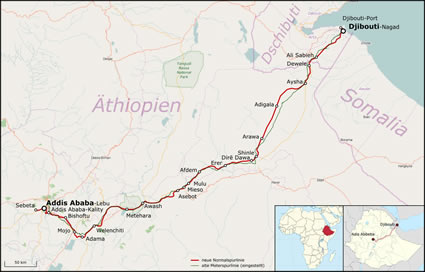Press Release
Chinese Railway Project Saves Lives in Ethiopia
February 2016
 View full size By rendering with Maperitive, text and integration: PechristenerEthiopia location map.svg: NordNordWestEthiopia on the globe (Africa centered).svg: TUBS [CC BY 3.0 or ODbL], via Wikimedia Commons
Map of Addis Ababa-Djibouti Railway.Standard Gauge Railway to open in 2016 shown in red. Small green line for the disfunctional meter gauge railway. |
February 23, 2016 (EIRNS)—This story was published in the Feb. 25 issue of the weekly EIR Strategic Alert Service published in Europe.
Ethiopia is currently suffering from one of the worst droughts in its history, but unlike 30 years ago, hundreds of thousands of people are not dying of starvation. The contrast can be attributed to two important changes. First, the current government has aggressively implemented an economic development policy which, in the last decade, has lifted millions of people out of poverty and made Ethiopia one of the fastest-developing economies in Africa. Second, an over 800-km-long railway has been built by the Chinese, connecting the port of Djibouti and Addis Ababa, the Ethiopian capital.
The railway, which was completed late last year, has reduced shipping time from up to three weeks for trucks to only five hours by train! This has enabled the government to transport the grain and other food products it has bought overseas to the 8.2 million people affected in the drought-stricken areas, in a matter of hours and days, thus saving thousands of lives.
Despite its obvious benefits, neither the International Monetary Fund nor the European Union has agreed to finance the railway. Thus, the Chinese not only built the line, but ended up funding most of the $3 billion project.
The Djibouti-Addis Abada line is just the first of a planned 5,000-km national network that will link the country with Sudan, South Sudan, and Kenya. And that, in turn, will be part of the East African railway network, also backed by China. That network, according to the East African Railway Master Plan, will connect railways in Kenya, Uganda, and Tanzania, extend them to Rwanda and Burundi, then to Sudan and Ethiopia to the south.
Last September, Ethiopia completed its first light rail network—the first in all of Sub-Saharan Africa. It connects the airport and the city of Addis Ababa. It was also built and financed by the Chinese. The chief executive of the Ethiopian Railways Corporation (ERC), Getachew Betru, has said that his dream is for the Ethiopian network to link into a trans-African rail line to the Atlantic.
Getachew also believes that Ethiopian railways could play a crucial nation-building role in Somalia, which is still struggling to become a rising nation. Pointing to the fact that Ethiopia is landlocked and dependent on the crowded port of Djibouti, and is the largest country in the region as well as the potential economic powerhouse, he said it will need access to other ports. Somalia has the port of Berbera, which is currently functioning but under-utilized. It is located in Somaliland, which declared independence from Somalia, but it is not recognized internationally.
Nonetheless, with a master plan that seeks to integrate, through railways, all of Somalia with Ethiopia and the other countries in the region, the basis will be laid for solutions to such thorny questions of national unity.
